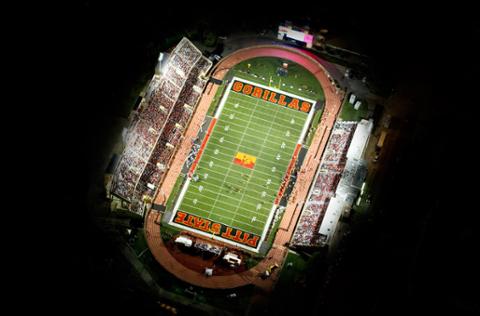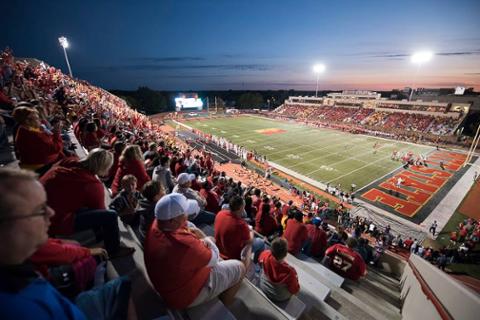Carnie Smith Stadium
Home to the winningest football program in NCAA Division II, Carnie Smith Stadium is widely regarded as one of the finest stadiums in Division II.
The stadium stands as a testament to the passion students, faculty, alumni and the community have for Gorilla football. These groups came together in 1923 to provide the necessary funding and labor to construct the original 5,000 seat stadium.
The stadium’s inaugural game was played in 1924 before nearly 4,000 fans. Pittsburg State, then known as Kansas State Teachers College, defeated Baker University by a score of 6-0 on their way to a Kansas Intercollegiate Athletic Conference title.
It was the first of many Gorilla victories inside the friendly confines of Carnie Smith Stadium. In fact, Pittsburg State holds one of the best home-field advantages in college football, winning 73 percent (343-125) of their home-games since 1924.
The facility was originally known as Brandenburg Stadium, in honor of William Aaron Brandenburg, the first president of Pittsburg State University. In 1987, the university announced that the field would continue to bear the name of Pittsburg State’s first president, but that the stadium would be named Carnie Smith Stadium, in honor of the legendary football coach who led the Gorillas to two NAIA national championships (1957 and 1961) and six conference titles during his 17 year tenure (1949-1966).
The stadium has undergone many changes in its first century of existence.
In 2001, the university celebrated the completion of a $5.7 million expansion project which added a second-level of seating on the stadium’s east side along with 16 luxury skybox suites, elevator access, new restrooms, concession stands, ticket booths and renovated locker rooms. The project also added 2,300 seats bringing the total seating capacity to 7,950.
In 2006, a $2.6 million expansion allowed eight luxury skybox suites to be added to the west side of the stadium along with elevator access.
Fans soon noticed something was missing from the stadium and in 2008, the university unveiled the stadium’s first-ever video board. Dubbed the “Jungletron” the $1.7 million LED board provides fans with 2,800 square-feet of vibrant video and scoring updates. It remains the largest university stadium video board in Kansas.
Each of these projects was funded by private donations from students, faculty, alumni and community members; just as the original stadium was constructed in 1923.

